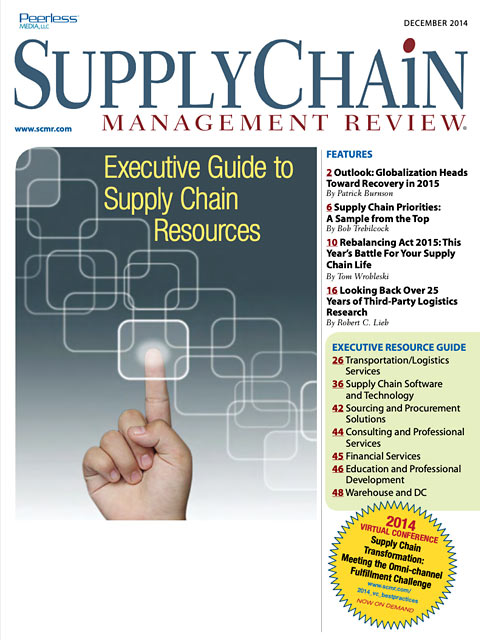Sorry, but your login has failed. Please recheck your login information and resubmit. If your subscription has expired, renew here.
December 2014
By the time you receive your copy of the December issue of SCMR, the holiday rush should be ready to peak and taper off as we all look forward to the year ahead. This issue can help readers prepare in several important ways. This issue also brings you our annual Executive Guide to Supply Chain Resources. This is a comprehensive guide to services, products, and educational opportunities targeted to supply chain professionals. The editors at SCMR wish all of our readers a successful year to come. We hope that the information and insights in this issue will play a part in that success. Browse this issue archive.Need Help? Contact customer service 847-559-7581 More options
The most significant tradeoff companies make in short term supply chain decisions is the tradeoff between transportation cost and inventory. As nearly every reader of this article will know, the speed and reliability of transportation affects the amount of inventory in the supply chain; shifts in these costs tend to create a lag until a new equilibrium is established.
Direct transportation costs can be influenced internally through activities like regularly scheduled negotiations and forming core carrier relationships. However, overall market conditions exert a strong invisible hand on transportation rates to determine a cost range, which negotiations cannot change. Similarly, the cost of keeping inventory is largely driven by interest rates set by the Federal Reserve.
The largest economic component of holding inventory is the cost of capital. When the cost of debt shifts significantly up or down, there tends to be a lag of at least two quarters before equilibrium is reached.
 |
This complete article is available to subscribers
only. Click on Log In Now at the top of this article for full access. Or, Start your PLUS+ subscription for instant access. |
SC
MR
Sorry, but your login has failed. Please recheck your login information and resubmit. If your subscription has expired, renew here.
December 2014
By the time you receive your copy of the December issue of SCMR, the holiday rush should be ready to peak and taper off as we all look forward to the year ahead. This issue can help readers prepare in several… Browse this issue archive. Access your online digital edition. Download a PDF file of the December 2014 issue.
 |
Download Article PDF |
The most significant tradeoff companies make in short term supply chain decisions is the tradeoff between transportation cost and inventory. As nearly every reader of this article will know, the speed and reliability of transportation affects the amount of inventory in the supply chain; shifts in these costs tend to create a lag until a new equilibrium is established.
Direct transportation costs can be influenced internally through activities like regularly scheduled negotiations and forming core carrier relationships. However, overall market conditions exert a strong invisible hand on transportation rates to determine a cost range, which negotiations cannot change. Similarly, the cost of keeping inventory is largely driven by interest rates set by the Federal Reserve.
The largest economic component of holding inventory is the cost of capital. When the cost of debt shifts significantly up or down, there tends to be a lag of at least two quarters before equilibrium is reached.
 |
SUBSCRIBERS: Click here to download PDF of the full article. |
SC
MR


Latest Supply Chain News
- Tech investments bring revenue increases, survey finds
- Survey reveals strategies for addressing supply chain, logistics labor shortages
- Israel, Ukraine aid package to increase pressure on aerospace and defense supply chains
- How CPG brands can deliver on supplier diversity promises
- How S&OP provides the answer to in-demand products
- More News
Latest Resources

 Explore
Explore
Topics
Latest Supply Chain News
- Tech investments bring revenue increases, survey finds
- Survey reveals strategies for addressing supply chain, logistics labor shortages
- Israel, Ukraine aid package to increase pressure on aerospace and defense supply chains
- How CPG brands can deliver on supplier diversity promises
- How S&OP provides the answer to in-demand products
- AI, virtual reality is bringing experiential learning into the modern age
- More latest news
Latest Resources

Subscribe

Supply Chain Management Review delivers the best industry content.

Editors’ Picks





